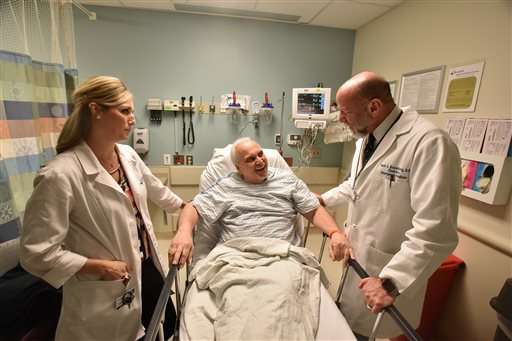As crisis rages, hospital works to reduce opioids in the ER

Mark Rosenberg doesn't need to go to his job as chairman of emergency medicine at New Jersey's busiest emergency room to get a bracing insight into the mushrooming problem of opioid abuse.
He can think of his own mother-in-law, who was treated at an emergency room for chronic wrist pain stemming from a fall, received five Percocet tablets and was told to see her family doctor—who then prescribed 100 more.
"She's 93 years old," Rosenberg said Monday. "A hundred Percocet! The point is that our culture is such that it's really out of control."
To combat what health professionals say is a nationwide epidemic, Rosenberg's hospital, St. Joseph's Regional Medical Center in Paterson, has been using opioid alternative protocols in its emergency room since January.
The goal of the Alternatives to Opiates (ALTO) program is to try to treat most patients without opioids before considering using them. In the first two months, 75 percent of the 300 patients that have gone through the program did not need opioids, Rosenberg said. Patients with cancer or those with chronic pain who are already dependent on opioids aren't part of the program.
The program at the hospital, about 20 miles northwest of New York City, comes as public health and law enforcement officials around the country are working to tame the deadly opioid crisis.
Opioids are highly addictive drugs that include both prescription painkillers like codeine and morphine, as well as illegal narcotics, mainly heroin. More than 29,000 people died from opioid misuse nationwide in 2014, the highest figure on record, according to the Centers for Disease Control.
The CDC this month released the first national guidelines for prescribing opioids. They urged doctors to first try non-opioid painkillers, physical therapy and other methods to treat chronic pain.
Emergency rooms find themselves at the front lines of the addiction epidemic, according to Andrew Kolodny, director of Physicians for Responsible Opioid Prescribing. They deal with people in real pain that need to be treated, addicts who lie about symptoms to try to score drugs, and overdose patients.
"I think it is unique that they're going to do a variety of measures to avoid" using opioids, Kolodny said of St. Joseph's. "In many cases, we're exposing people to opioids when we don't need to be."
In New York City, health officials have issued voluntary guidelines on how its public hospitals should prescribe opioids. Other hospitals around the country have also worked to reduce the use of opioids, including chronic pain policies that limit the use of the powerful drugs, using prescription monitoring programs, and educating physicians to use non-opioid alternatives.
Sergey Motov, the associate research director at Maimonides Medical Center in Brooklyn, has been outspoken on the idea that doctors should be prescribing less opioids. He said doctors should be using a targeted approach to pain management and that more of his colleagues are beginning to embrace the change, including at Maimonides.
"I have no problem with opioids, I have a problem with the way we use them: unintelligently, without understanding them," Motov said. "We need to talk to patients. The patient needs to be given an option. We never talk to patients routinely...we just blindly give them medication and hope they feel better."
Rosenberg gave an example of a patient with a dislocated shoulder. Where opioids might previously have been prescribed, the emergency room would instead administer a nerve block to numb the area and allow the shoulder to be put back in place.
That could last for days, he said, and could be followed by non-opioid pain relievers such as acetaminophen.
"We have to get over the acute pain episode," he said. "Really the first 24 to 48 hours are the worst. If I can get you over that, you're going to feel a lot better."
© 2016 The Associated Press. All rights reserved.

















